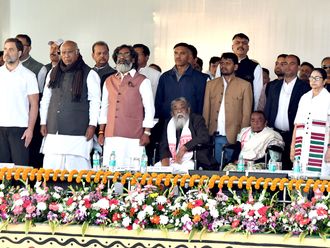The demand for a national caste census could be the gamechanger for the 2024 general elections. Bihar Chief Minister Nitish Kumar made a smart political move this week by releasing the findings of a government caste survey in his state.
The numbers are: over 63 per cent of the population is from backward classes, which includes OBCs (other backward castes) and EBCs (extreme backward castes). This is a more than 10 per cent jump from the last caste census in 1931. The break-up of castes in Bihar today: EBCs form 36 per cent of the population, OBCs 27.1 per cent, while 19.1 per cent are from Scheduled Castes and 1.7 per cent from Scheduled Tribes. The general category, which includes the so-called upper castes, accounts for around 15.5 per cent.
Demand for national caste census
The report underlines that backward castes and marginalised groups will be key players in the Lok Sabha (lower house of parliament) election. The implications of the Bihar survey go far beyond the state and will force all political parties to tweak their election strategies.
The opposition has in recent months stepped up demands for a national caste census, arguing that accurate data was the only way to ensure that policies benefit people who need them the most. Bihar-based parties like Nitish’s JDU and the RJD lead the clamour for a caste census. Rahul Gandhi threw weight behind this in the last few months with a strong pitch, and the INDIA opposition alliance (barring Mamata Banerjee) is also on board.
The Rohini Commission, set up to look at the sub-categorisation of OBCs, has recently submitted its report to the president, and the BJP could use that as a counter.
For the BJP, it has increasingly appealed to OBC voters over the last few general elections. From 34 per cent in 2014 when Narendra Modi first came to power at the centre, the OBC vote has jumped to 44 per cent for the BJP in 2019.
However the party does not fare well among OBC voters at the state level. As leading psephologist Sanjay Kumar of the Centre for the Study of Developing Societies wrote in ‘The Indian Express’ in 2021, during the 2019 Lok Sabha elections, only 11 per cent of OBCs in Bihar voted for the RJD, but during the 2020 Assembly elections, 29 per cent backed it. In Uttar Pradesh, in 2019, only 14 per cent of OBC voted for the Samajwadi Party, but during the 2017 Assembly elections, 29 per cent supported it even though it lost the election badly.
Clamour for job quotas
To complicate things further, OBC representation in key positions has not been adequate, a point that Congress leader Rahul Gandhi made when he pointed out recently that only 3 out of 90 secretaries to the government were from the OBC community. The BJP fears a national caste census precisely for this reason. The data may lead to a clamour for new quotas in government jobs and educational institutions, and it will give a new lease of life to regional parties, like the RJD and the JDU, which thrived on the social justice politics of the 1990s.
Now, with the announcement of the Bihar caste data, the BJP needs to work on a new strategy and a sharper response. When the report was revealed, Union Minister Anurag Thakur said the issue required “comprehensive study”.
Some BJP leaders have been pushing the top leadership to urgently address the job quotas for OBCs and EBCs in government. The Rohini Commission, set up to look at the sub-categorisation of OBCs, has recently submitted its report to the president, and the BJP could use that as a counter. But it also risks upsetting its upper caste base.
Hindutva and nationalism may not be enough of a binding force among voters in 2024. This is exactly what happened in 1990, when the BJP was at the height of the Ram temple movement and VP Singh used the Mandal report to give reservations to OBCs.
Ultimately, the caste numbers have to be used in a way that uplifts and gives opportunities to those who need them. For that, the role of political players will be key. The Lok Sabha polls just got more interesting.







_resources1_16a45059ca3_small.jpg)

